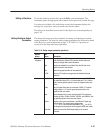
Operating Basics
AWG610 Arbitrary Waveform Generator User Manual
2-45
Signal Edit Process
This subsection describes the signal edit process.
Load the desired waveform data to be output into the waveform memory. New
waveform data can be created using waveform editors incorporated in the
AWG610 Arbitrary Waveform Generator. New data can also be created by
combining the following:
H A sample waveform data distributed with floppy disks.
H Previously created waveform data on the built-in hard disk.
H Waveform data measured or created by other equipment, which has been
read through the network.
Each AWG610 Arbitrary Waveform Generator file may be for either an analog
(extension .WFM) or digital pattern (extension .PAT). For analog waveform, the
full scale of the DAC is represented as –1.0 to 1.0. This range is held with a
resolution of 8 bits. The two pieces of marker information, as well as waveform
data, are included.
To enable editing, the AWG610 Arbitrary Waveform Generator provides you
with Waveform, Pattern, Sequence, Equation, and Text Editors. See Table 2–16
for the explanations of those editors.
Table 2-16: Editors
Editors Descriptions
Waveform Editor The Waveform Editor lets you create or edit a waveform that is being
displayed on the screen. It enables you to create any waveform by an
operation such as cut and paste, partial inversion about the horizontal or
vertical axis, shift, or scaling. This operation can be based on a standard
waveform, such as a sine or rectangular wave, or the previously created
waveform.
The Waveform Editor also has a unique feature that is capable of editing a
waveform with waveform calculation functions (absolute value of waveform,
differentiation/integration, convolution, correlation, addition/subtraction/multiĆ
plication between waveforms and so on).
Pattern Editor The Pattern Editor displays a digital signal pattern with a pattern data placed
in 8Ćbit creation waveform memory; it creates a digital signal pattern
according to the High/Low settings you made for the individual bits.
In addition to the functions supported by the Waveform Editor, the Pattern
Editor is capable of generating frequently used digital signals unique to
digital signals and pseudo random patterns.
Waveform Data Structure
Waveform Edit


















